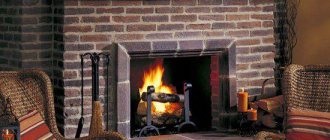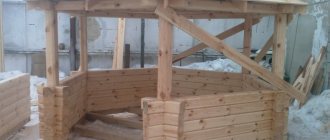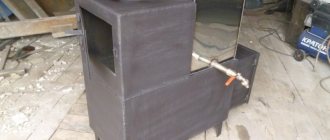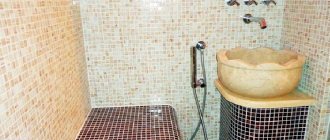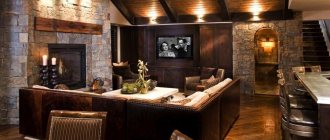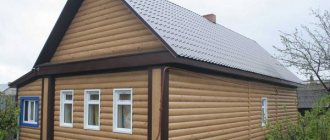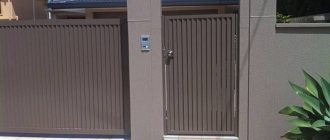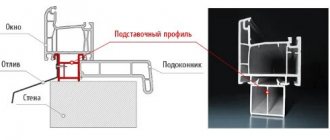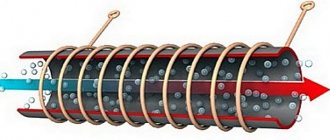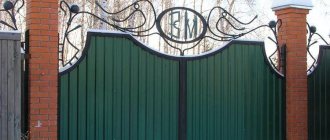In large country houses there is plenty of space for fireplaces of any design. But in country houses with a small area, heating devices must be installed in relation to the size of the building. We can offer several options and tell you about stoves, fireplaces, and how to build small combined structures for a summer residence.
A small fireplace stove contains two heating devices combined with each other. Its design has three advantages: simplicity, compact size and good thermal characteristics, which is why it is chosen by amateur gardeners for installation in their country houses. The construction of this device will solve several problems: it will heat the room and create conditions for cooking.
Fireplace stove in the country
Stove heating design
Before direct construction work, a special design must be made.
Its formation is considered a rather complex job, which requires the ability to make certain calculations. It includes a detailed diagram of the future stove, as well as the order and some other documents. The project should include many nuances, so it is important to take into account the following features of the house itself and the future stove when creating it:
What material is the house made of, since it can be formed from timber or SIP panels, and you often have to install a fireplace or stove in a frame structure. Will the design be a cooking-heating one or will it be intended exclusively for heating premises; Will the fireplace or stove heat two or more rooms? What will be the configuration of the structure, as well as its shape, for which a separate diagram is made. Since the stove is usually made of brick, order is important, and the choice should fall on high-quality and reliable brick. It is important to consider the size of the building itself, since the power of the resulting heating structure must be appropriate. The project must contain calculations of the thickness of the walls of the future structure, its height, features of the material from which the chimney will be made, as well as other nuances and elements of the work that will be implemented with your own hands.
Pros and cons of combined devices
A brief summary of the theory described above will be the highlighted advantages and disadvantages of fireplace stoves. Among the advantages it should be noted:
- Combining a stove and fireplace into a single device saves space without losing the basic functional qualities of each of them.
- The ability to switch between modes allows you to use the design for a short stay in the house or as a real heating system.
- The fairly large power of the furnace will ensure heating of the coolant, which means that such a system can be equipped with a water circuit.
- Additional options in the form of a hob, barbecue or oven emphasize the versatility of the stove.
- The radiation of the fireplace and the heat transfer of the stove, when combined, increase efficiency by up to 80%. Using a fireplace stove, you can fill several rooms with warm air at once.
Good to know: Electric oven for baking at home
The disadvantages of such devices are rarely discussed, but they exist:
Firebox design for a multifunctional brick structure
In the first place is the huge mass of the furnace.
- It will not be possible to build a fireplace stove in a hurry, since any arrangement is a rather complex scheme.
- Complexity in structure determines complexity in maintenance. Often it is necessary to clean the channels, for which it is necessary to partially disassemble the labyrinth of the furnace, and this is a rather labor-intensive task.
Consider air circulation.
To effectively heat a room, consider air circulation: warm air rises and cold air descends.
Therefore, when choosing a stove or fireplace, think about their placement. You may need to purchase a ceiling fan or other appliances. If the fireplace is located on the first floor, and the second floor is also planned to be heated, you need to look at how warm air will be supplied there. The first option is free circulation. But then the heating will be uneven: distant rooms are colder and take longer to warm up. And if the rooms are isolated (the door is closed), they will not warm up at all, or the heating will take a very long time. The second option is to separate the hoses with warm air, when warm air from the heating device goes through the air duct and enters the room through the ventilation grille. Here you need to take into account how long the sleeves need to be pulled - if the length is long, you may need a special fan.
What problems may this device have?
Fireplace stoves have several disadvantages. Namely:
- Uneven heating of rooms. Warm air accumulates at the top, and the bottom is poorly heated.
- It is necessary to periodically “feed” fuel so that the heat is retained for a long time.
- During long periods of inactivity, dust accumulates. And when heated, it burns and gives off an unpleasant odor.
- Some models are too expensive.
The fireplace stove is an amazing and multifunctional device that will decorate and fill any home with warmth. But when choosing, it is important to take into account the size of the room so that it does not interfere with the passage and evenly heats the entire volume. The chimney must be insulated, otherwise fumes and soot will enter the room.
Types of foundations for a stove in a wooden house
When choosing a suitable foundation, consider the following:
- Installation cost – the price of building materials, installation and preparatory work is taken into account.
- Characteristics of the foundation and soil characteristics - the choice is based on the total weight of the structure, the type of soil (clayey, sandy, black soil, stone).
- Dimensions of the foundation for the stove in the house - depending on the area occupied by the stove equipment, the total weight of the structure, the required type of foundation is calculated.
All existing foundations are usually classified into several groups:
- On stilts and pillars.
- Concrete bases.
Foundations on piles and pillars
The base is made in three ways:
If you want to make a foundation for a stove in a wooden house with your own hands, without involving outside help, it is better to choose a pile structure, which is easy to install and does not require (with the exception of a screw device) serious material investments.
During installation, the foundation is insulated, thereby preventing the appearance of condensation on the walls of the furnace or cladding. Pillars without insulation will be “cold bridges,” which will negatively affect the operation of furnace equipment.
Concrete bases
Advantages of the device: ability to withstand heavy loads of strength, possibility of self-production, relatively low financial costs.
Cons: time required for installation and excavation work.
Concrete foundations are made in two ways:
The foundation gains strength gradually. Installation of a metal furnace and lining it with stone begins no earlier than 28-30 days after pouring the concrete.
Floor placement (floor installation)
Existing building codes for installing a home heating stove in a wooden house allow the installation of equipment that does not have cladding directly on a wooden floor. When installing on the second floor, you will need to strengthen the logs with metal corners and channels.
To prevent fire, the tree is protected with a metal sheet or a clay-brick layer. Otherwise, installing a wood-burning stove in a wooden house yourself is not difficult.
Manufacturers of heating equipment must provide detailed installation instructions. By following the recommendations and the step-by-step installation plan specified in the technical documentation, you can independently install the stove and connect it to the chimney.
Foundation
The foundation is a very important element for all buildings, but not all double-sided fireplaces require it.
- A reliable foundation will be mandatory for brick buildings, and it is advisable that it be separated from the general foundation of the house, since they can influence each other negatively. If you plan to install two fireboxes in the fireplace, separated by a wall and located in different rooms, then you will have to make a foundation in both one and the second room.
The foundation for a brick double-sided fireplace is arranged according to all the rules that are developed for the designs of stoves or classic wood-burning fireplaces.
- A plasterboard structure does not require such a reliable foundation, since it does not have much weight.
- Ready-made double-sided fireplaces that run on biofuel or electricity also work well without first installing a base for them.
- Naturally, hanging fireplaces do not require a foundation, but you will have to work hard to strengthen the ceilings and securely fasten the structure.
Main characteristics of home heating stoves
The main characteristics of home heating stoves that need to be taken into account when choosing a design are heat capacity and cooling time.
Active volume
- a quantity characterizing the volume of the furnace mass, which is heated during the combustion process (including the voids of the structure). Its value is determined by the product of the calculated (active) height of the furnace and the area of the lower level of the firebox. The active height in the calculations is taken to be from the bottom of the firebox (or the bottom of the flood channel located below) to the upper (if the thickness of the ceiling is less than 14 cm) or lower (14 cm) plane of the ceiling. If the active volume is 0.2 m3 or more, then such furnaces are classified as heat-intensive; if less than the specified value, they are classified as non-heat-intensive.
Based on the temperature of the heat-releasing surface of the furnace, they are divided into:
- moderate heating (those with a wall thickness of 12 cm or more are heated to 90 °C);
- increased heating (those with a flue wall thickness of up to 7 cm are heated to 110-120 °C);
- high heating (surface heating temperature is not limited).
Depending on the movement of flue gases, furnaces can have the following schemes:
- flue gases move through channels connected in series: single-turn - with one lifting channel, double-turn - with two lifting channels;
- flue gases move through channels connected in parallel: single-turn, double-turn;
- flue gases move freely: ductless (bell-type);
- flue gases move through a combined system of channels with bottom heating: with a channelless overhead part, parallel, sequential;
- flue gases move through channels connected in series around the hot-air chambers.
Classification of stoves by type of finish and solid material in descending order of heat capacity: brick tile; brick and metal in cases; brick plastered; steel with an internal lining of refractory bricks; concrete made of heat-resistant blocks; cast iron without lining.
Flue gases in furnaces can be discharged:
- through root and mounted chimneys;
- through internal channels.
In-wall smoke ducts are laid in the brickwork of the building. The furnaces are connected to them with metal pipes placed horizontally. The length of these pipes should not exceed 40 cm. Mounted pipes are located above the stoves. Sometimes the main pipes are laid on independent foundations.
According to their functional purpose, furnaces are divided into the following types:
- heating;
- household;
- special;
- heating and cooking;
- heating stoves;
- combined.
It is desirable that the selected design has a high coefficient of efficiency (COP), warms up well over the entire surface and releases heat evenly throughout the day. The stove must be simple, technologically advanced, reliable in operation and safe.
The heat generated by the stove must correspond to the heat loss of the room. In this case, the air temperature in the room will always remain at the desired level.
Required thermal insulation materials
Stone wool 50 mm thick serves as a fire shield between the chimney and other building elements. It is necessary to take this moment responsibly, especially when it comes to transition nodes in the areas of interfloor and attic floors.
The fireclay core and facing parts are sometimes separated by basalt cardboard, which has low thermal conductivity. Thanks to this thermal insulation layer, the temperature of the working core is maintained and the outer part of the fireplace does not overheat.
The tightness of the junction of metal elements to the brickwork is ensured using sealants that can withstand high temperatures. If this is not done, there will not be good draft in the chimney, which means the performance of the heating structure will decrease.
Application of protective screens
Screens are shields made of brick or metal that protect walls from intense thermal radiation. Similar protection is used when installing metal stoves.
- Metal screens are made from steel or cast iron sheets, these
casings surround the heat source with a distance of 3-5cm.
Advice! When purchasing a metal sauna stove, you should give preference to a model equipped with a metal casing. Its cost is not much higher, but the issues of wall insulation are eliminated.
Additional frontal or front shielding, which is located on the walls depending on the location of the stove, will not hurt. The protection guarantees the wood from overheating, reducing the temperature by 100 degrees or more, and provides the opportunity to save space in the steam room. A stove protected by a casing can be installed at a distance of 50-55cm from the wall.
Installation of screens is simple. The casing, equipped with legs, is secured to the floor by side or front screens - with galvanized nails or self-tapping screws.
- Brick screens are masonry used to cover the stove with
on all sides, the same casing, only made of brick. Another method is to lay half a brick between the firebox and a wall made of solid fireclay bricks laid on a solution of clay and cement. The width of the wall should be 120mm, although there is an opinion that it is permissible to put 60mm in a quarter of a brick, but it should be remembered that in this case the thermal insulation value is reduced by exactly half. It is recommended to raise the height of the masonry 20-30 cm above the surface of the firebox, but if you raise it to the ceiling, it will not be worse.
The screen should be placed at a distance of 10-15cm from the wall, 5-15cm from the stove, that is, the space saving is 30-40cm
Important! Functional openings for heat exchange should be made at the bottom of the masonry. Protective screens are effective, they reduce the temperature to a level acceptable when using high-temperature fuel units
The same function is performed by wall cladding made of non-combustible materials.
Protective screens are effective; they reduce the temperature to a level acceptable when using high-temperature fuel units. The same function is performed by wall cladding made of non-combustible materials.
Basic requirements for combined models
There are often concerns about the safety requirements for combined fireplaces and stoves. All points, including the correct choice of location, are considered relevant.
It is necessary to plan the installation of a fireplace stove as early as possible. It's not just that you'll have to dismantle the floor to build the foundation. Just the presence of such a massive unit in a room cannot but affect its layout. Therefore, assume in advance that there are no wooden walls or flammable materials nearby. If it is not possible to exclude a dangerous neighborhood, then the entire coating should be provided with fire-resistant insulation.
Proper start-up of a new furnace is considered the key to its reliability. Fulfill all requirements for drying a newly built structure. Other issues related to the safety and compliance of the product are provided for in the finished designs of fireplace stoves.
Types and features of two-story stoves
Two-level hearths come in two types: with one and with two fireboxes. For a country home, the most interesting are two-story “Swedes”, complemented by a hob. There are modifications with beds, but heavy extensions are always on the ground floor. On the second level, a false or functional fireplace is sometimes built; the first increases heat transfer, and a full-fledged fireplace insert helps to quickly warm up the room.
In models with one firebox, the combustion chamber is located on the ground floor, while vertical channels must be provided on the upper level. For separate heating of floors, dampers are used to block the movement of flue gases.
Stove for a two-story building with one firebox, stove and fireplace
Some stove makers do not recommend choosing models with one firebox for your home, since cooling flue gases form condensation in the second-level heating panel, which destroys the masonry. Designs with two fireboxes heat the room faster and are more convenient if there is often a need to heat one floor. Schemes of stoves with two fireboxes necessarily include two-channel chimneys.
Modern brick two-story fireplace with two fireboxes
Brick stoves for a two-story house weigh almost twice as much as standard modifications, so a reliable foundation is necessary. The interfloor ceiling must be no less durable - a reinforced concrete slab capable of supporting the weight of a brick building. The installation location is chosen along the main internal walls.
Location of brick fireplace stove
To decide where it is best to install a fireplace stove, you need to know the layout and dimensions of the house.
Optimal solutions for the location of the fireplace stove:
- in the middle of a large common room;
- in the center of the building at the junction of interior partitions;
- in the wall between the common room and the kitchen area;
- between the hallway and the bedroom.
If you place the fireplace stove in the center of the room near (against) one of the internal walls, several rooms are heated at once. It is convenient if the heating stove, which serves as a fireplace and cooking apparatus, is located between the common room and the kitchen. The fireplace side will be in the family room and the cooktop will be in the kitchen area.
The heat shield plays the role of a warm partition if the stove is built between the living room and bedroom.
Important! During operation, the fireplace “eats” a lot of oxygen. Therefore, the area of the room where it is installed should not be less than 15 square meters. m.
The greater the power characteristics of the combustion chamber, the more spacious the area of the fireplace room should be.
To improve the microclimate inside the building and ensure normal combustion, additional air supply is provided. This can be done in different ways. Regular window vents or special channels for air flow from the street will do. Their diameter depends on the type of combustion chamber. For a closed firebox, the channel is made at least 10 cm, for open fireboxes - at least 20 cm.
Heating a one-room house
There are three ways to place a stove in a house where there is only one room and there is not a single wall, even separating the kitchen or hallway.
- If the room is not very large, the fact that free space comes to the fore. A stove, even the smallest one, if placed in the middle, will steal a lot of it. In this case, the heat output will be maximum, there is nothing to say here, but constantly cruising around it is not entirely convenient. This option is suitable only with a spacious room.
- If you place the stove against the wall, there will be more free space. But, you say, in this case one working surface of the wall will work idle, directly heating the wall near which it is located. This is true, and in this case the wall must be protected from overheating using thermal insulation materials. Or place the stove so that there is a small gap between it and the wall, at least 15 centimeters wide. And the wall will be safe, and the warm air circulating in this opening will also work to heat the entire room.
- In very small houses, a stove of a special design is placed in the corner, observing all safety measures. Usually two work surfaces are enough to heat the entire room.
However, we must not forget that real skilled stove makers can even make a small stove in such a way that it can accommodate a stove, an oven and other auxiliary devices. Well, if used correctly, it will heat no worse than a real Russian village stove.
Double-sided electric fireplace in the interior
To determine which fireplace to choose for your home, you need to see how it looks in the interior.
An unexpected bold decision - a double-sided fireplace in the bathroom
A very interesting solution for installing a double-sided fireplace in the bathroom. It is especially pleasant to take a bath in such an environment during the cold season, since just the sight of fire has a warming and relaxing effect on a person’s perception. If such a fireplace is installed between the bedroom and the bathroom, it will bring even more comfort, since, coming out of the hot water, it is so pleasant to lie down in bed and watch the movement of the flames. The fireplace is built into the wall, decorated with stone tiles in restrained, calm tones, which will allow you to relax not only physically, but also mentally. It should be noted that this is a bold, original solution to install a double-sided fireplace, which is not designed for display for guests, but for one’s own comfortable well-being.
Double-sided fireplace in the image of a Russian stove
The design of this fireplace resembles a Russian stove. It is an attribute of the interior, which with its white color illuminates the entire room, dividing it into two zones, similar to separate rooms, due to the size and location of the building. A niche designed for storing firewood also adds coziness. Despite the massiveness of the stove-fireplace, the furnishings in the room do not look overloaded; rather, it can be called light and bright.
Fireplace with original semicircular firebox
This version of a through fireplace does not divide the room, but it is also installed in a very original way - its back wall seems to fit into the window. The fire in this fireplace will look especially impressive in the dark; it will not only decorate the interior with its sparkles, but will also illuminate it with a mysterious playing light. Another feature of this fireplace is its unusual semicircular shape and the same shape of the door and glass. While burning, the flame will gently slide along the smooth curve of the glass, creating a special magical impression.
Protective screens near or around the oven
Such a system will need to be implemented when installing a potbelly stove in the corner of the room. You can mount or lay out several screens from brick, installed at a short distance from each other. In this case:
- The first screen protects a person from touching the iron stove and getting burned. It is usually made of refractory or fireclay bricks;
- To protect walls made of flammable material, a second layer of protection is provided. It can be made of brick or covered with a barrier made of sheet steel with a mirror-like front surface. In this case, heat waves will be reflected from the mirror and spread faster throughout the room;
- if the foundation is insufficient in size or it is impossible to manufacture it, it will be necessary to lay a protective screen made of durable fire-resistant material on the wooden floor. This can be a sheet of steel or a decorative layer of heat-resistant clinker tiles or porcelain stoneware. The surface will first have to be covered with a layer of thermal insulation.
Installation of metal screens
This is the easiest way to make surface protection. It is better to use sheets with a polished front surface. Before fastening, the wall surface at the required level along the height of the screen is covered with a layer of thermal insulation. In this way, we protect the surface of the walls from the effects of heat.
You can lay a layer of thermal insulation or fasten the metal with self-tapping screws with inserted ceramic spacers. But it is better to attach the screen to strips or a metal profile treated with a layer of protection. In this option, the air gap will not allow heat to pass freely to the walls, and reliable insulation of the stove from the wooden wall is ensured.
A special gap is made at the bottom of the wall for the passage of cold air, ventilation of the wall and screen. When arranging a wall with a layer of thermal insulation, a number of longitudinal guides are installed on the surface. The space between them is filled with a layer of mineral wool or other material. Then sheets of metal are installed and screwed to the sheathing with self-tapping screws.
In this design, there is no need to leave a gap at the bottom. The air will not be able to pass through calmly, but the wall will be reliably protected from high temperatures. To protect the floor of the house, a slab made of non-flammable durable material can be used.
Brick screens
This protection option is usually installed near the stove. Thus, you can protect not only the wall, but also the person from burns. By installing a brick wall, you can reduce the distance from the stove to the wall. For laying, it is better to use ceramic or fire-resistant bricks.
The work is carried out in several stages:
- you will need to make a small foundation or remove boards from the floor along the marking lines for laying the screen and, by drilling holes in the concrete of the base of the building, insert metal rods to fasten the bottom of the wall and the foundation;
- Having leveled the floor surface, lay out a layer of mortar and lay the first row of bricks; you need to place the bricks in the same plane without distortions. This determines how level your entire wall will be. Do not forget to make small grooves for ventilation; for this you can move several bricks of the bottom row.
- checking the level and pulling the twine for laying each subsequent row, all bricks are laid on a mortar of clay and sand. Having raised the wall to the required height, the top is sealed with a layer of mortar or covered with a board. This way you can make a shelf for decorative ornaments and all sorts of little things.
The brick is laid no higher than the top of the furnace at a distance of at least 40-100 mm from it.
Using both types of protective screens, you can reduce the distance from the oven to 500 mm.
Examples of installation of protective brick screens in the photo:
Selecting the size of the finished double-sided firebox
The easiest way, of course, is to purchase a ready-made double-sided fireplace insert in a store; it will look good both in appearance and in functionality it will please the owner. Beautiful welding seams, spectacular painting and other decorative little details of factory fireboxes clearly distinguish them from homemade ones. Look at this photo:
Ready-made factory firebox for a two-sided fireplace
Manufacturers, knowing the different tastes of consumers, try to satisfy all needs. Therefore, if you buy a cast iron firebox, you can find exactly the option that is more suitable for the fireplace itself and for the interior in which it will be located.
- Cast iron fireboxes are available in different sizes, and they are used in different fireplaces, as well as as an independent stove, equipped with a stand. For example, as done in the presented photo.
You can do it in the simplest way
- Fireboxes have different shapes, from classic rectangular and square to semicircular and asymmetrical.
- The walls of the firebox are reliable, as they are finished with fireclay material or have a heat-resistant layer between two metal sheets.
- Fireclay tiles made to resemble stone or brick are well suited for wood-burning brick fireplaces. They will go perfectly with the exterior decoration of the portal.
- Cast iron fireboxes usually have a horizontal arrangement, but some models are also made in a vertical version.
- Fireboxes, as a rule, have two hermetically sealed doors made of heat-resistant glass, which will allow you to admire the flames from both sides. This glass is designed to withstand high temperatures, reaching up to 700-750 degrees.
There are also more original door options - they can rise up or slide to the side.
Basically, the glass installed in the doors has a straight, even shape, but in some models trapezoidal and semicircular glass is used.
It must also be said that some models of fireboxes are equipped with automated doors, one of which is blocked when lighting a fire in the fireplace, in order to avoid drafts and fire.
If you want to admire a live fire in an open firebox, one of the doors can be open, but the second one must be closed.
If a bio-fireplace is installed, then the firebox for it is usually included. An electric fireplace that has the effect of a living fire also has a ready-made firebox, for which you only need to create a suitable portal.
What criteria should a stove for a summer cottage have?
Many consider the best option for heating a dacha to be a traditional brick stove (Russian, Swedish or Dutch). However, such devices are intended for constant use and are not very suitable for irregular heating, because... take too long to heat up. Sometimes, depending on the weather, they sometimes need more than a day to raise the temperature in the house.
To quickly warm up a room that has not been heated for weeks, not traditional, but modern metal stoves - Buleryan, Breneran, Butakova - are better suited. They provide a comfortable temperature much faster – within a few hours
What else is important when choosing a means of heating a summer house?
- Easy to install. Not everyone is ready to spend a lot of effort and money on building a reliable and massive brick stove in a small country house.
- Fast heating of the room. A summer resident, having decided to visit his dacha on the weekend, does not agree to sit in a cold house for a long time - he wants to quickly find himself in the warmth.
- Furnace burning time. Getting up at night, in the cold, to add wood to the firebox is not a job for the faint of heart. And during daylight hours, you don’t want to spend the whole day working on the stove. What kind of vacation is this?
- Fire safety. Many country houses are made of wood, so the issue of reliability and safety of heating equipment comes first.
Safe Operation
A double-sided fireplace is an interesting design, but when using it you need to take into account some points in order to only enjoy its presence in the house and not have unpleasant problems:
- The first rule that must be followed is not to leave the fireplace unattended while it is burning.
- Do not open both doors at the same time to avoid burning wood or sparks falling onto the floor surface. In addition, a draft can create a reverse draft, and smoke from the firebox can enter the room, and this is an unpleasant odor that is quickly absorbed into furniture and clothing.
- Another important step is to decorate the fireplace area with non-combustible material, for example, ceramic tiles, and this must be done on both sides of the firebox.
- To avoid excessive smoke in the firebox and get high-quality heat, you need to use fairly dry firewood.
Thermally efficient stove with one firebox
This two-story model has a high heat capacity - one firebox per day for 2-2.5 hours is enough to heat a house. Fuel consumption is about 60 kg of dry firewood. Average heat transfer is 5500 kcal/hour.
Description of design and materials
The channel single-turn furnace has one firebox on the ground floor. Dimensions of the building: 89*115 cm. Height – 715 cm. Dimensions of the heating panel on the lower floor are 77*102 cm, on the second floor – 77*95 cm. Heat exchange outlets are provided in the lowering channels of the smoke circulation panels, increasing the heating rate and heat transfer.
For masonry you will need the following materials and stove equipment:
- 1900 pieces of red ceramic bricks;
- 170 pieces of fireclay bricks;
- 2.1 m3 of red oven clay;
- 0.2 m3 of refractory clay;
- 2.3 m3 of mountain sand;
- grate (40*40 cm);
- steel sheet (50*70 cm);
- firebox door (35*35 cm);
- blower door (13*12 cm);
- 5 cleaning doors (13.5*12 cm);
- 2 valves (13*26 cm).
Sections of the building and masonry diagram
A detailed arrangement of the stove on 2 floors clearly shows the structure of the smoke circulation channels and the principle of gas movement. Red and fireclay bricks in the scheme are easy to distinguish by color.
Important! Ceramic and refractory bricks cannot be bound in one dressing. The scheme is completed by a shell-type pipe erected directly above the furnace
The scheme is completed by a shell-type pipe, erected directly above the furnace.
Sections of a two-tier oven
Masonry from 1 to 64 rows
Top rows diagram
The presented model is designed for a ceiling height of 3.4 m, but if necessary, the structure can be easily reduced or enlarged by making amendments to rows 26 to 46 and 60 to 82.
Note! Modernization will entail changes in the heat transfer characteristics specified in the description
Chimney from a pipe
Having made a metal fireplace with your own hands, you can proceed to an equally important stage - preparing the chimney. It does not require welding work. It is recommended to use ready-made steel pipe.
Exiting the pipe to the roof
The pipes are joined using the provided socket. This is a special extension that allows you to insert one end of the pipe into the other. If there is no such socket, then the edge of the pipe should be cut with metal scissors, and the junction of the pipes should be treated with heat-resistant sealant.
A direct-flow duct is not a mandatory requirement for a chimney for metal fireplaces. Various elbows can be used to direct the smoke along the desired path.
When passing through ceilings, you will definitely have to take care of safety by insulating the chimney. Asbestos material or mineral wool are suitable for this. This procedure is also expected when the pipe exits the roof.
Real live fire
The top of the pipe is covered with a canopy. It will prevent precipitation from getting inside the pipe and will protect against excess debris, and will also prevent sparks from flying out.
How to help the stove burn more efficiently
How can you “make” a metal stove heat up longer and perform the function of heating a house more efficiently? Let's look at some options:
Some summer residents recommend covering a metal stove with bricks. In their opinion, the building will first heat the bricks, and they, in turn, giving off heat, will warm the house. This is the operating principle of a conventional stone stove. Theoretically, this is true, but there are a few caveats. Firstly, the brick will still not heat up as much as in a traditional oven, which means you will not achieve the desired effect. Secondly, you will also reduce the service life of your stove. Due to the lack of free space, the metal case will not cool well. For this reason, the metal will burn out faster. And finally, due to the strong heating of the case, the risk of fire increases. By the way, some people line a metal stove with bricks (about 2/3) for safety reasons. in the lower part, such devices get quite hot. Another option used by summer residents is a water tank. Suitable for ovens with a horizontal top surface. Place a container filled with water on top. During strong combustion, the water will heat up, and then it will gradually give off its heat to the room
This method cannot be called very effective, but the heat of the heated water will be enough for some time. It is also important what kind of firewood you use for heating. Here, pay attention to 2 criteria: combustion temperature and the amount of tar, tar, oils, etc. released during combustion. – substances that contribute to the formation of soot. Soot is formed when burning any wood.
However, most of the substances that clog the chimney are present in coniferous firewood (resin), in birch logs with bark (it contains tar) and in fuel briquettes, which consist of seed husks (oil). Therefore, they should be avoided whenever possible. We recommend using hardwood firewood for heating: they produce a lot of heat and few soot-forming products. The quality of the fuel you “feed” your stove is also of great importance. Under no circumstances should you burn waste left over from repairs in a stove: remnants of fiberboard, chipboard, laminated chipboard, etc. This will harm not only the heating device, but also your health. We also do not recommend burning branches, tree trimmings and similar debris without first drying them, because firewood (or the material that replaces it) must be as dry as possible (according to the instructions for such stoves, their humidity level should not exceed 20%). When undried wood burns, moisture evaporates. Water vapor rises. There they encounter small particles of ash, which are formed during combustion, and glue them together. The resulting pieces settle on the walls in the form of soot and soot. Thus, wet wood clogs your stove. Thirdly, when using such firewood it is not possible to reach the same temperature as when burning dry firewood. Metal stoves are not designed to hold heat at all. They only heat while they are burning. Therefore, in order for the device to warm the air for as long as possible, it is necessary to properly organize the combustion mode. Such stoves have a long burning mode. It is quite economical, because... does not require the use of large amounts of fuel.
Summer residents who have been using similar heating devices for many years recommend the following algorithm of actions:
- Light the stove and heat it well.
- When the wood burns with a bright flame, add an armful of dry firewood to the firebox - about 2/3 of its volume. Some add firewood in combination with fuel briquettes, some add only briquettes (not made from seeds).
- Close the valve and the vent. Due to the lack of oxygen, the firewood will not burn with a strong flame, but will only smolder. Thanks to this, one bookmark can last for 7-8 – or even more – hours. This method saves fuel and your energy, and also provides a constant comfortable temperature in the room.
Each heating device requires special treatment. If you study all its whims and fulfill all its wishes, it will thank you with its warmth.
Stove and fireplace two in one: design projects, photos
Based on their location, universal combined devices can be divided into types:
- wall-mounted, which are capable of heating several adjacent rooms at once;
- corner - have a compact size and fit well into the interior;
- floor-mounted - they produce maximum power and quickly heat the room.
You can choose a fireplace stove based on functionality and interior features. Below are the most popular models.
- Guca Lava. Wood-burning, cast iron and floor-standing fireplace stove. It has high heating power and a laconic design, and melts quickly. Retains heat for a long time and takes up little space. Its disadvantage is that the handles for the valves are not very comfortable.
- Stove-fireplace "Rumba". Floor-standing, made of steel, so light in weight. It has a stylish design and a convenient compartment for firewood. Due to the thermal characteristics of the materials, it cools quickly.
- "Teplodar". Corner version of the fireplace stove. Compact, capable of heating up to 120 m³, heated with wood. The set includes a box for ash and a shelf for storing firewood.
- "Meta Cupid". Steel corner option. Thanks to the large compartment, it can burn for up to 8 hours. It has a modern and stylish design, high. There is an ash drawer, a firewood shelf and a spare multifunctional shelf.
- ABX Admiral. It has an unusual shape, which allows you to simply place it against a wall or in a corner. Capable of heating up to 140 m³. Looks stylish, made of high-strength steel.
- "Marseille 14". Made from quality materials, suitable for residential buildings with an area of 200-250 m². It heats the entire house evenly. Can be heated with wood or pellets. The style of the model is suitable for any interior.
- "Bavaria 3 glasses". It has an unusual elongated shape. It can be installed in the passage between rooms. Heats up to 120 m³. Keeps warm for up to 6 hours. Easy to install and use. There is another option - a corner one with a stove, more compact and multifunctional. Capable of releasing heat for up to 6 hours and heating up to 195 m³. Thanks to the light design, it looks visually light and small in size.
- La Nordica Nicoletta. A popular model with a bright red design. Capable of heating up to 229 m³. It runs on wood, there is a compartment for storing wood and ash. Heavy, high quality materials. Has a stylish design.
- Thorma Milano II. Fireplace stove made of steel. Light in weight and compact, does not require a foundation. Can heat up to 124 m³. There are several colors to choose from.
- La Nordica Ghisa. Cast iron model, can heat up to 340 m³. Equipped with a stove for heating and cooking. Eco-friendly and economical option. A cozy and large fireplace stove creates comfort in the home. There is a brick, compact modification consisting of 200 bricks. It is small in size, located between two rooms like a partition, it heats two rooms at once. It can also be equipped with a kitchen stove for cooking or a bench seat.
- Stove-fireplace "Swedish". A hob and oven are built into this design. On one side there is a fireplace to heat the room and create coziness, and on the other there is a stove and a panel for cooking. The stove can be positioned so that 3 rooms are heated at once.
Made of brick
Brick models are fireproof and are used for heating houses and baths. The main advantages of such structures:
- durability and strength;
- resistance to temperature changes;
- keep warm for a long time;
- melt quickly.
The disadvantages are the high price and the lengthy laying process.
On a note!
Construction work is carried out only by professionals according to the agreed scheme with the correct order.
With a bed
A classic Russian stove with a fireplace and a stove bench serves not only as a place to relax, but also acts as a drying place for shoes and clothes, gifts of nature - mushrooms, berries, herbs. To warm up the bed, several dampers are installed. In summer, you don’t have to warm it up by closing the partition. The size and shape of the bed are selected according to the design project at the request of the customer.
For a two-story house
Such a fireplace stove is built from brick with a pipe on two floors at once. The fireplace is usually located in the living room and heats it. Stove - in the kitchen for cooking and heating all other rooms. It is built thoroughly, with a foundation and all walls laid with non-combustible materials. Built-in plugs can be used to regulate the heating of rooms.
Cast iron models
The cast iron fireplace stove is durable and of high quality. It has a long service life. Advantages:
- reliability;
- there is no deformation due to temperature changes;
- long-term heat retention;
- long service life.
The disadvantages include the heaviness of the design and the high price.
On a note!
The styling for fireplace stoves can be selected to suit any interior. You can opt for decorative cladding with bricks, stones, and panels.
How to protect a country house from fire when installing a stove
- Use of thermal insulation materials with a high degree of fire resistance to protect walls and ceilings at the installation site.
- Application of fire protection: impregnations and mastics.
Fire retardant treatment of wooden structures
Mastics and impregnations have been developed for protection. The former provide better fire protection, the latter are almost colorless.
The order of installation regarding fire safety measures specified by the manufacturer is specified in the technical documentation. Fire protection work is carried out by representatives of the Ministry of Emergency Situations. You can take measures to prevent fire yourself, but before putting the stove into operation, you will need to obtain a certificate from the inspector of the Ministry of Emergency Situations about the fulfillment of all requirements of the safety regulations.
Detailed parameters for installing a solid fuel heating country stove are described in the technical documentation attached to the heaters of leading European and Russian factories. Compliance with the described rules is mandatory.
Since ancient times, it was believed that the stove in the house was the main property. It doesn’t just heat and makes it possible to cook tasty and healthy food. She is a symbol of comfort, a home that should be preserved and protected. Therefore, skilled stove makers have always been considered a privileged caste. After all, the home nurse had to be built in such a way that it could be quickly and hotly heated, so that in the most severe frost the whole house would be warm and cozy, and the sizzling of the cooking food and the aroma of pies would spread from room to room. But before you start building, you need to calculate the location of the stove in the house. So that not a single molecule of heat is wasted.
The first and immutable requirement when choosing a furnace location is the complete design of the house. That is, the location of the stove in the house should be planned simultaneously with the walls. In this case, it will not happen that one room will be unbearably hot, and the other will be bitterly cold. And it’s much easier to pour the foundation under it before the floors are laid.
But there are other rules that should be followed.
Under no circumstances should the foundation for the stove be connected to a common foundation. Over time, the house will definitely shrink and the least that will happen is that the stove will become covered with cracks, from which wisps of smoke will constantly curl, making it impossible and even dangerous to stay in the room. Well, at most it will simply warp and require a lot of repairs. The location must be selected in such a way that the chimney is in close proximity to the internal main wall
It will be possible to support the pipe on the ceiling beam. Be sure to take into account the layout of the house. Number of rooms and windows
The need to heat the second floor, if there is one. And the material from which the house is built. Next, the approximate heat loss of the entire structure is calculated. From here the heat transfer of all surfaces of the stove is calculated. The design of the furnace itself must also be thought out in advance. Well, one last thing. If the house is too large and one heating device is not enough, you should calculate how many stoves will need to be installed and in what places.
Many years and even centuries of experience show that building too many chimneys means consuming an increased amount of firewood. There is no need to make a separate stove for each room. This is why it is called an ideal location, because with a minimum of space, the largest possible area is heated.
And one more important fact
A stove, no matter what type of fuel it is heated with, is a device around which some amount of garbage, dirt, ash, soot and other dirty substances always accumulate. Therefore, it is better to make the firebox hole in the room that is closest to the front door
Then you won’t have to carry firewood, buckets and bags of ash across the whole house. Believe me, after these voyages the rooms will definitely have to be cleaned.
Features of chimney installation
The inner surface of the chimney pipe is a straight channel, but its outer part has design features.
Design features keep you warm
At the intersection of the floor beam, the chimney has an expansion. This design element is important because it reduces the temperature of the outlet streams. As a result, there is no need to make additional thermal insulation in this place.
At the level of the intersection of the roof, the chimney has an extension. This feature protects the brickwork from the harmful effects of precipitation.
The smoke channel is also protected in the form of a metal cap. It is recommended to equip the chimney with a spark arrester.
Advantages and disadvantages of combined heating devices
The advantages of fireplace stoves include:
- the ability to quickly heat the room;
- good heat storage capacity;
- high performance;
- heat transfer at the level of the best heating units;
- versatility;
- possibility of using for heating several rooms;
- increased emissivity;
- the presence of additional functional elements for cooking, drying clothes or relaxing.
As for the disadvantages, these include low efficiency and uneconomical design operating in fireplace mode, the need to clean additional smoke channels, the need for good ventilation and high-quality air flow. An obvious disadvantage is the complexity of the design, as well as the impressive dimensions of the structure.
Merging options
There are several approaches to solving the problem of combining two structures. Their type depends on the stage at which such a decision was made. The most popular are two ways to accomplish the task.
- Installation of two fireboxes in one housing. As a rule, already at the stage of pouring the foundation it becomes known that the future structure will perform two types of tasks. The body of the fireplace is laid out according to a certain pattern, in which two fireboxes are formed. One firebox belongs to the stove, and the second to the fireplace. Common models are those that are a stove on one side and a fireplace on the other. These devices heat different rooms, and it seems that they function separately.
- Equipping the furnace firebox with a glass door. This allows you to turn a stove into a fireplace with a minimal investment of money, preserving all the functional features of the original device. Thus, a fireplace stove is obtained thanks to an elementary addition.
In general, combining a stove and fireplace made of brick is not so difficult. But the stumbling block is always the chimney. The fact is that, according to calculations, the areas of the smoke channels do not coincide. Metal structures successfully cope with this problem by installing an average option. Brick models often require the installation of two separate chimneys.
Undoubtedly, if two devices are combined into one, then there are only one advantages, however, in the case when the originally built stove was built by your predecessors and you want to make two functional devices out of it, you will have to call a professional craftsman. Even if you plan to carry out all the work yourself, you need a clearly developed plan. It will tell you exactly how to implement the join.
